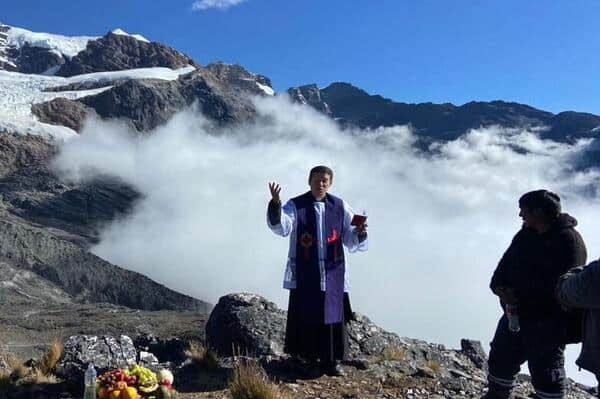Peru: Challenges in the ‘land of saints’
“You cross the Amazon jungle and climb more than three miles above sea level in the Andes Mountains. You head into the desert. You are now in what Pope Francis calls ‘the land of saints,’” says Luis Vildoso, director of projects for Aid to the Church in Need (ACN) in Peru.
In an interview with ACN after his recent trip to Peru, Vildoso describes the challenges that the Church faces in distant parts of the country.
There are several old dioceses in Peru, such as Cuzco and Lima, which were created in 1536 and 1541, respectively. What role does the Catholic Church play in Peru today?
Peruvian society recognizes the Church’s value and its great importance. In cities like Lima, Cuzco, and Arequipa, you see its presence in the many chapels, in the names of streets and districts, and in the legacy of more than 50 Peruvian saints, blesseds, and venerables.
When we were speaking to foreign missionaries in the country, they told us that the Church in Peru is like a garden that needs to be cared for and watered, because it is quite easy to proclaim the faith. There is a great thirst for God, and there is strong popular piety.
The Church is present where no other institution goes. The Church has played a pivotal role in the evangelization of the Peruvian Amazon, in the southern Andes and in some peripheral urban regions. It is dedicated to the material and spiritual needs of the population. According to the testimonies of love and commitment that many people shared with us, I am convinced that these priests and missionaries see the face of Jesus in the people, who have a great thirst for God.
How do the laypeople cooperate with the Church’s mission?
Pope Francis said that Peru is a “land of saints,” and this is reflected in the expressions of faith one can see in different places. During our trip, it was beautiful to see how in the Amazon, the laypeople keep the Church alive. They are true heroes, the guardians of the faith in their communities, because there are hardly any priests or religious around. It is the laypeople who celebrate the liturgy of the word, for instance, and they express their faith with joy, so that the people do not lose theirs.
In the Apostolic Vicariate of Yurimaguas, our visit happened to coincide with a formation session for laypeople, which had the support of ACN, and it was very interesting to see how they were given Biblical formation to sustain their communities, which are now faced with growing sects.
Was there anything during the trip that especially caught your attention?
I have fond memories of our trip through the Santiago Apóstol de Huancané prelature. We had breakfast with a priest in his parish house, and with a family that is responsible for looking after the church. When we finished speaking, and they had told us about all their needs, we went to the church, which is next to the house. As soon as we entered, the whole family fell to its knees and began to pray in Quechua. They exuded a very deep sense of religiosity and reverence because they realized they were in the presence of the Blessed Sacrament.

I should also mention the missionaries, who serve in very remote places in Peru. The experience of meeting them moved my heart. But at the same time, it was a reminder of how tough missionary work is. These people risk their lives. The road to Sandia, for instance, in the Huancané prelature, runs next to a deep precipice; many of the roads here are not even paved. The missionaries travel great distances and weather a merciless climate. They travel through the fog and are exposed to the sun and cold of the mountains. But they are willing to endure these extreme conditions to live with and serve the neediest people.
What are the greatest challenges for the Peruvian Church?
One of the biggest challenges is that in all the places we visited, there was a great shortage of clergy and religious. In Arequipa, we visited a cloistered monastery of the Congregation of the Justinian Canonesses Regular, whose vocation is to pray for the clergy. We have the contemplative Church praying for the Lord to send workers into his vineyard .
The second challenge is the contrast between Peru’s rich cultural heritage and natural resources, and its social injustice and inequality. But despite this painful reality, the Church is evangelizing, proclaiming values, and accompanying the people on their spiritual journey.
Poverty is also a great challenge for the local Church, because the communities don’t generate enough money to provide for their priests or the pastoral work. Finally, some of the Peruvian mission zones are very distant and difficult to get to, from the top of the Andes to the depths of the jungle. There are also communities that can only be reached by crossing rivers.
How is ACN helping the Church in Peru?
ACN’s contribution to the country goes back a number of years. The impact of this assistance can be seen in the formation of the clergy, which is still ongoing. In many places, the priests will tell you that they managed to complete their training because of ACN. The training of seminarians is one of our priorities. We need to recognize the importance of faith formation and take Pope Francis’ words, that this is a “land of saints,” seriously.
It was beautiful to see that in places like the Huancané prelature, the congregation of the Missionaries of Jesus, Word and Victim manage the distribution of ACN publications such as the Children’s Bible, and “I Pray the Rosary.” The sisters use them for the spiritual nourishment of the population.
—Maria Ximena Rondón

